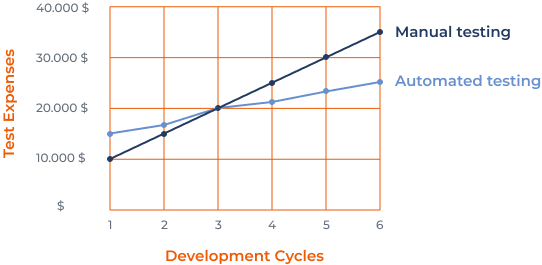Is your website designed for everyone? Perform an accessibility scan.
Is your project ready for Test Automation?
Have you ever considered automating your testing processes but you want to be sure that this type of service will fit your QA needs? Let's see which tasks it will help you solve:

speed up the
release of your
product
avoid human
errors during
testing
make testing
faster and more
scalable
expand test
coverage
decrease testing
costs and get higher
ROI in the long run
reduce the effort of
manual testers by
60-70%

Let's check whether you are ready for automation together
If you answer 'YES' to at least 3 of the following questions, then automated testing will be especially useful for you.
01 Would you like to reduce the time spent on repetetive checks?
02 Would you like to increase testing quality and find more bugs before the release?
03 Is there a need to make test maintenance less costly?
04 Would you like to support your QA processes with test documentation and then reuse it for future checks?
05 Is fast and accurate feedback on the results of tests an important aspect for you?
If you are not sure which parts of your testing process to automate, we can help you by:
- manual Exploratory testing to define where automation would be optimal
- preparing a free estimation of the scope of work on your project to provide you with custom solution. This usually takes around 3 days. Sounds useful?

Let us help / What we offer
QATestLab's team can start automating your testing processes from scratch or work with autotests that have already been created.
This includes creating test cases, running them manually, writing test scripts, and automating them. In addition, our experienced Project Managers or QA Tech Leads can also be involved to monitor all testing activities on your project so that you will be able to focus on other high-priority goals.
Our automation QA engineers can assess your automated software checks, update them to cover new functionality and improve your automated processes. This way, you will get a fresh perspective on your QA activities and additional expertise to save even more testing resources.
We'll have your questions answered

Test Automation FAQs
To help you take the most advantage of automated testing and answer your questions, we gathered the most important points from our automation QA experts.
While manual testing is performed by QA engineers themselves and they execute each software check manually, test automation allows running tests with the help of specific code and tools. Setting up such a process requires a larger initial investment due to the work of highly-skilled QA engineers with the knowledge of programming languages and automation tools. However, in the long run, automation becomes more cost-efficient than manual testing, which is illustrated in the graph below:
Manual vs Automated Testing

Launching test automation is a time-consuming process because it requires pre-written test cases that will be automated, and selecting the proper testing tool. Although once everything is set up, it drastically reduces the time and effort spent on testing. One of the examples is that an automation tool can run tests in batches and overnight, without the presence of a QA engineer.
Specific figures differ from project to project. One of the brightest examples of how effective automated testing is in terms of speeding up QA processes is that regression testing, which would take weeks of manual work, can be completed within one day if it is automated.
Although many types of tests can be automated, some of them will not lead to desired results without manual coverage. For example, UX/Accessibility testing, Ad-hoc testing, Exploratory testing, etc. There are also particular elements of the software's functionality that can't be tested with the help of automation tools. These include moving elements of the interface, third-party integrations, 2-factor authentication, etc.
Having test documentation is the first step in setting up automated checks. In particular, your QA processes should be supported with test cases, which are the basis for developing test scripts and creating further automation infrastructure. If you would like to create detailed and transparent test documentation for your project, our manual QA engineers would be happy to help.
Do you have any other questions?
Case Studies
Automated functional testing of a B2B solution
This platform is a B2B solution that helps companies, which are partners or vendors and clients, to get different levels of isolated access to data.
PROJECT REALIZATION:
- Our team performed automated functional testing of the system.
- We've achieved test coverage of more than 90% of functionality.
- Test execution time has been significantly reduced.
- We've helped to increase software quality and reliability, as well as time and resources flexibility.
- The following tools were used during QA: Selenium RC, JUnit, Testlink, TestNG, Jira.
- Our team has provided the following documentation: a test plan, automated test scripts, regular bug reports, and a final report.
Automated testing of a web app for room reservation
The website, which belongs to an international hotel chain, allows visitors to conveniently choose and reserve hotel rooms using a filter.
PROJECT REALIZATION:
- The QATestLab team automated functional tests for the website.
- Our QA engineers also created automated regression tests for the application.
- The QATestLab experts have provided recommendations on how to improve the solution.
- We've provided detailed documentation on how to use the developed auto scripts.
Automated Testing for Healthcare Application
A complex software product for the healthcare and life science industry, which was designed for patient enrollment and retention. It consists of three parts: questionnaires to select relevant patients for medical trials, a subsystem for sending retention letters, and another subsystem for creating and managing reports, as well as managing data about the patients
PROJECT REALIZATION:
- To provide real-time feedback about the state of the software, we executed tests for every subsystem and analyzed their results daily
- To ensure the stability and high quality of the product, our team performed stress/load and regression benchmark tests before deployments
- We also executed smoke/regression testing right after deployments to find new issues as soon as possible
- Our QA engineers maintained existing automated tests and added new ones on request to optimize our customer's testing resources
